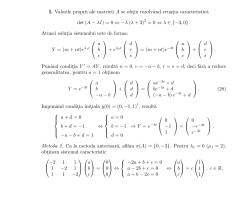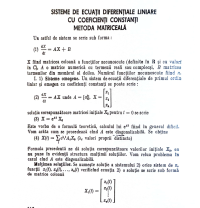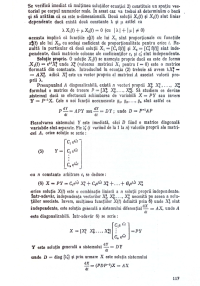You are using an out of date browser. It may not display this or other websites correctly.
You should upgrade or use an alternative browser.
You should upgrade or use an alternative browser.
Eigenvalue Method as a diferential equation!
- Thread starter wolly
- Start date
And n=0 c=-a-b r=d=sI don't understand the context, and I cannot read Romanian, but here is what I think about your first question:
[imath]m+nt[/imath] appears because [imath]\lambda_1[/imath], which is equal to -3, has multiplicity of 2.
IT says that IT results from Y'=AY?
Do You have Something like a PDF that can show me how to solve this?I don't understand the context, and I cannot read Romanian, but here is what I think about your first question:
[imath]m+nt[/imath] appears because [imath]\lambda_1[/imath], which is equal to -3, has multiplicity of 2.
@blamocur How did these 3 solutions come from?And n=0 c=-a-b r=d=s
IT says that IT results from Y'=AY?
@logistic_guy A Little help here!
blamocur
Elite Member
- Joined
- Oct 30, 2021
- Messages
- 3,220
Not sure about [imath]n[/imath], but the rest is derived from the fact that (a,b,c) and (d,r,s) are eigenvectors of A.And n=0 c=-a-b r=d=s
blamocur
Elite Member
- Joined
- Oct 30, 2021
- Messages
- 3,220
No, I don't have it. But it looks like pretty standard stuff about ODEs with constant coefficients. Don't you have a textbook? Where does this problem come from? Is it part of your homework?Do You have Something like a PDF that can show me how to solve this?
IT comes from a math college contest exercise book and I know how to solve some parts but not all of them!No, I don't have it. But it looks like pretty standard stuff about ODEs with constant coefficients. Don't you have a textbook? Where does this problem come from? Is it part of your homework?
I am referring to the eigenvalue and eigenvector Matrix Equations
Attachments
blamocur
Elite Member
- Joined
- Oct 30, 2021
- Messages
- 3,220
You need to learn the subject in a more systematic way. Asking for help on a forum is no substitute for studying.I am referring to the eigenvalue and eigenvector Matrix Equations
The idea is as follows. If we have [imath] (A-\lambda I)(x)=0, [/imath] i.e. [imath] Ax=\lambda x [/imath] then we solve [imath] y'=\lambda y [/imath] and obtain [imath] y=me^{\lambda t}. [/imath] However, we actually have for [imath] \lambda=-3 [/imath] that
[math] (A-\lambda I)^2(x)=0. [/math] That means that either [imath] (A-\lambda I)(x)=0 [/imath] is already zero, in which case we get the solution [imath] y=me^{\lambda t}, [/imath] or, and this is different, that [imath] (A-\lambda I)((A-\lambda I)(x))=0.[/imath] Now
[math] (A-\lambda I)(A-\lambda I)=A^2-2\lambda A +\lambda^2 I=0 [/math]and we have to solve [imath] y''-2\lambda y'+\lambda^2y=0. [/imath] Let's see if [imath] y=nte^{\lambda t} [/imath] is a solution for this equation.
[math]\begin{array}{lll} y&=n te^{\lambda t}\\ y'&=ne^{\lambda t}+n\lambda te^{\lambda t}=n e^{\lambda t}+\lambda y\\ y''&=n\lambda e^{\lambda t}+\lambda y'=2n\lambda e^{\lambda t}+\lambda^2 y \end{array}[/math][math]\begin{array}{lll} y''-2\lambda y'+\lambda^2 y&=2n\lambda e^{\lambda t}+\lambda^2 y-2\lambda(n e^{\lambda t}+\lambda y)+\lambda^2 y=0 \end{array}[/math]
Hence, it is a solution. Combining both, we get
[math] y=me^{\lambda t}+n te^{\lambda t}=(m+nt)e^{\lambda t}.[/math]This is the solution space for the generalized eigenspace [imath] \lambda=\lambda_1=-3 [/imath] with multiplicity two.
If we finally add the solution space for the generalized eigenspace [imath] \lambda=\lambda_2=0 [/imath] with multiplicity one, then we get
[math] y=(m+nt)e^{\lambda_1 t}+pe^{\lambda_2 t}=(m+nt)e^{-3t}+pe^{0\cdot t}=(m+nt)e^{-3t}+p. [/math]The parameters [imath] m,n,p [/imath] result from the initial values for the differential equation.
[math] (A-\lambda I)^2(x)=0. [/math] That means that either [imath] (A-\lambda I)(x)=0 [/imath] is already zero, in which case we get the solution [imath] y=me^{\lambda t}, [/imath] or, and this is different, that [imath] (A-\lambda I)((A-\lambda I)(x))=0.[/imath] Now
[math] (A-\lambda I)(A-\lambda I)=A^2-2\lambda A +\lambda^2 I=0 [/math]and we have to solve [imath] y''-2\lambda y'+\lambda^2y=0. [/imath] Let's see if [imath] y=nte^{\lambda t} [/imath] is a solution for this equation.
[math]\begin{array}{lll} y&=n te^{\lambda t}\\ y'&=ne^{\lambda t}+n\lambda te^{\lambda t}=n e^{\lambda t}+\lambda y\\ y''&=n\lambda e^{\lambda t}+\lambda y'=2n\lambda e^{\lambda t}+\lambda^2 y \end{array}[/math][math]\begin{array}{lll} y''-2\lambda y'+\lambda^2 y&=2n\lambda e^{\lambda t}+\lambda^2 y-2\lambda(n e^{\lambda t}+\lambda y)+\lambda^2 y=0 \end{array}[/math]
Hence, it is a solution. Combining both, we get
[math] y=me^{\lambda t}+n te^{\lambda t}=(m+nt)e^{\lambda t}.[/math]This is the solution space for the generalized eigenspace [imath] \lambda=\lambda_1=-3 [/imath] with multiplicity two.
If we finally add the solution space for the generalized eigenspace [imath] \lambda=\lambda_2=0 [/imath] with multiplicity one, then we get
[math] y=(m+nt)e^{\lambda_1 t}+pe^{\lambda_2 t}=(m+nt)e^{-3t}+pe^{0\cdot t}=(m+nt)e^{-3t}+p. [/math]The parameters [imath] m,n,p [/imath] result from the initial values for the differential equation.
Last edited:
logistic_guy
Senior Member
- Joined
- Apr 17, 2024
- Messages
- 2,223
Forgive me @wolly




